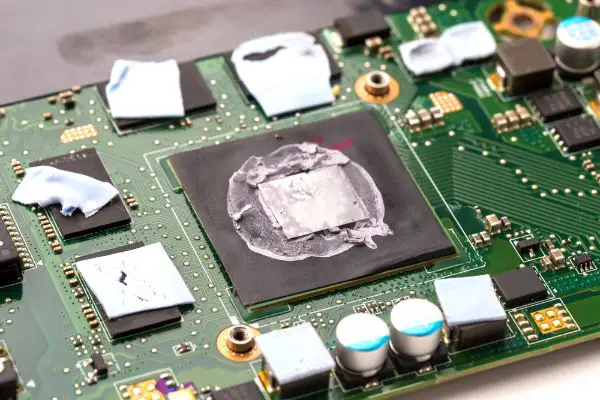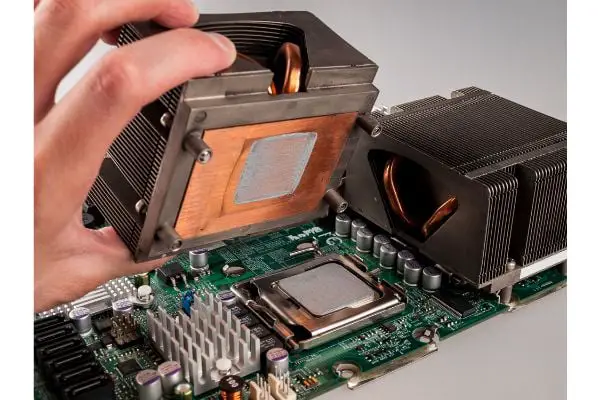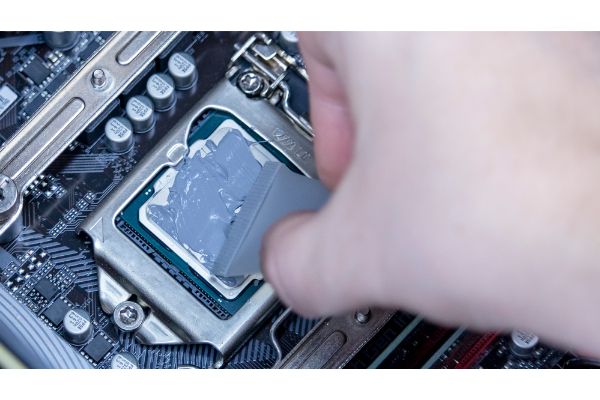Disclaimer: This post may contain affiliate links, meaning we get a small commission if you make a purchase through our links, at no cost to you. For more information, please visit our Disclaimer Page.
Modern computers are quite robust, but still contain some sensitive electronic components necessary for great performance. Overheating could be a concern if you are into any activities requiring heavy use of the microprocessor and other parts. Thermal paste is one way you can mitigate this issue.
Our article below will cover some common questions many new users might have about it.
Table of Contents
Can Bad or Dried Thermal Paste Cause Overheating?
Thermal paste is used widely by people who build or modify their PCs. Many people may be unfamiliar with thermal paste and what “bad” thermal paste might do to the computer’s components.
Some worry that old or dried-out paste could do more harm than good. There are a few key points to keep in mind here.
The primary focus of thermal paste is to siphon heat away from chips in computers or gaming consoles. These things build up a lot of heat as they do their jobs, and we do not want them to burn out.
If thermal paste dries out too much, it may be unable to transfer heat properly. When this happens, the chips in your computer may not get the cooling effect they need.
Therefore, in these rare cases, it is possible that “bad” or very dry thermal paste can fail to siphon heat, causing a buildup in the chips. To be clear, dry thermal paste doesn’t cause a device to overheat so much as it fails to perform.
In cases where thermal paste might not work, one of the more likely scenarios is that your PC or console will crank up the internal fan to compensate for the added heating problem.
Many modern devices have automatic shutoffs that will turn them off if too much heat is detected.
In addition to overheating, it is important to note that old or dried-up thermal paste does not typically cause any other issues in computerized devices.
If your device is experiencing other problems, they are almost certainly not caused by old thermal paste. The paste has only one function.
Will Using a New Thermal Paste Fix Overheating?
If you notice that your CPU is overheating, you should first check the status of your thermal paste.
Most manufacturers will tell you that the thermal paste they applied to the product should last from 3 to 5 years in total.
This is also true of extra thermal paste you might buy with your computer or console. Although this benchmark is acceptable, it will depend strongly on many factors.
Your computer’s thermal paste may not last as long, or it may be fine well after this date.
We recommend you check your computer’s heat buildup under a full load if you have not swapped out your original thermal paste for some of the new stuff within about 3 years.
If your computer is running close to or above 85 degrees Celsius when operating high-end games or other renders, consider changing the thermal paste as soon as possible.
Should you find your machine is overheating, switching out the thermal paste can be the first and best solution, and it will usually fix overheating issues. This may not be true in every single case, but with this being the primary purpose of thermal paste, it is a safe bet.
Furthermore, we recommend that you do not skimp on cheap thermal paste. Spend a bit more to buy quality stuff or well-known brands is a good idea.
Overheating could cause your machine’s failsafe to kick in prematurely and shut down. This might happen just seconds or minutes after booting up the device.
In other cases, you could have a damaged computer on your hands. It is best to go with a good thermal paste.
Do I Need To Replace Thermal Paste After Removing the Heatsink?
The answer to this question depends on a couple of things.
Was the thermal paste new or relatively new when you removed or refitted the heatsink? If so, you shouldn’t necessarily need to replace the existing thermal paste with a brand new application.
In these cases, you would notice a difference of one or two degrees at most. This might be worth it, but it is not strictly necessary.
Did the thermal paste get disturbed or knocked out of place when removing or replacing the heatsink? If so, you may want to go with a new paste application.
However, it depends on how much things changed during your heatsink removal process. So, if your paste is new, you should spread it evenly into the places it needs to go.
There’s nothing wrong with playing it safe and replacing the existing paste with a new layer. This replacement might be particularly important if you plan overclocking the device after everything is up and running.
As always, perform routine maintenance checks on the performance of your device to ensure proper functioning. If you aren’t getting the levels or specs you want, consider a new thermal paste application for proper cooling.
What Happens If You Don’t Reapply Thermal Paste?
For this question, we’ll assume that your thermal paste is old, dried out, or perhaps not there because of some modifications.
Remember that thermal paste has one job: to take the brunt of the heat between the sink and microprocessor.
If you need to run your computer at high settings for any reason, a lack of thermal paste can increase the risk of parts overheating. The lack of thermal paste will either cause a shutdown to protect the device or lead to failure.
If you run your machine at minimal levels only, all the time, it may be possible that thermal paste is unnecessary in your specific case.
However, you will likely need to use your computer more fully at various points, so we do not recommend that you skip out on reapplying thermal paste.
In short, no thermal paste means more air bubbles between the CPU and the heatsink. These gaps can trap particles that could impede the function of your computer. Additionally, it won’t be able to siphon heat as efficiently.
How Often Should I Apply New Thermal Paste?
Thermal paste can dry out over time, and this drying process can cause it to lose some effectiveness. It is a good idea to reapply thermal paste every so often for the best results.
Good thermal paste should be able to last several years. As long as the thermal paste is relatively new, anywhere between three to five years is normal.
Because of its shelf life, reapplying thermal paste very often will not necessarily improve your computer’s performance. In other words, applying new thermal paste every few months is not necessary.
A good rule of thumb is changing the thermal paste whenever you remove the CPU’s cooler for a good cleaning. However, this also depends on how often you remove the cooler.
In most cases, you will only see substantial differences in cooling if you haven’t changed your paste in about five years.
If you are noticing a dip in performance or excessive temperatures in your machine even though you have changed out the paste in the last couple of years, this is a case where you might need to reapply more if it is sooner than you would otherwise.
How Long Does Thermal Paste Last Once Applied?
We’ve mentioned that most people who build, modify, or otherwise work with computers agree that thermal paste should be good for at least three years once it is applied.
Many people are comfortable using thermal paste for up to 5 years minimum. However, there are a few things to keep in mind here.
The general climate, your computer’s cooling system, and the quality of the paste you purchase can all affect its longevity once you apply it.
It’s a good idea to use the thermal paste recommended for your specific CPU. While you can go with any paste, using recommended options could increase the life or effectiveness of the paste.
The average life of your paste might be shorter if you overclock your computer or frequently play games with high-end graphics.
Paste has a shelf life whether you store it or apply it. Examining its texture, you can check to see if your stored paste is still good. If the paste is very hard or seems watery, it is a good idea to get a new paste tube before applying it to your computer.
Conclusion
Thermal paste is an excellent product designed for one purpose, and it can do its job very well if you use it properly.
It won’t fix any issue with your computer’s internals, but it is often the easiest and best solution to an overheating problem.
Keep in mind that using the right kind of paste and applying it correctly is important.
Furthermore, only use the recommended amount of paste when it is time to reapply. Too much paste won’t increase the cooling effect, and it could lead to damaging the chip instead.



